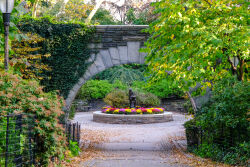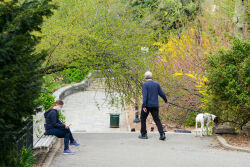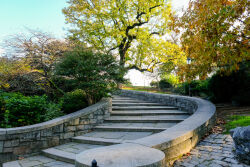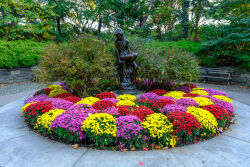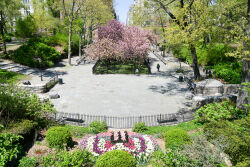Carl Schurz Park
Carl Schurz Park
What was here before?
The Algonquins were the earliest inhabitants of this land, which was valued for its strategic location overlooking turbulent waters of the Hell Gate at this bend in the East River. The first known European owner of the land was Dutchman Sybout Claessen, who was granted the property in 1646 by the Dutch West India Company. Jacob Walton, a subsequent owner, built the first house on the site in 1770. During the Revolutionary War, the Continental Army built a fort surrounding the Walton residence to guard the strategic shipping passage of Hell Gate. After a British attack on September 8, 1776, the house was destroyed and the Americans were forced to retreat from the fort, which the British retained until the end of the war in 1783.
In 1799, a prosperous New York merchant named Archibald Gracie built a country house on the land. .Bankruptcy forced Gracie to sell his house to Joseph Foulke in 1823. Foulke later subdivided the land, selling the mansion and some of the land to Noah Wheaton in 1857.
How did this site become a park?
In 1896, the City of New York seized the estate from Wheaton due to non-payment of taxes, incorporating its 11 acres of grounds into East River Park. It was renamed in 1910 for the German-American statesman Carl Schurz. The first home of the Museum of the City of New York (1924-32), the mansion has served as the official residence of New York’s mayors since Fiorello La Guardia moved there in 1942.
Illustrious landscape architects Calvert Vaux (1824-1895) and Samuel Parsons (1844-1923) completed a new landscape design for the park in 1902. Maud Sargent (1899-1992) re-designed the park in 1939 when the East River Drive underpass, now Franklin Delano Roosevelt Drive, was under construction. Sargent’s functional design used strategically placed boulders, plantings, and hardscaped plazas and walkways to obscure the new roadway below. The park’s waterfront promenade, built over the FDR’s roof deck, was named after City College president and New York State Commissioner of Education John H. Finley. In 1975 Charles Andrew Hafner’s (1889-1960) sculpture of Peter Pan, originally created in 1928 for the old Paramount Theater’s lobby, was installed in one of the park’s cloistered gardens.
Recent improvements include rebuilding of the stairs, the complete restoration of the playground and the opening of Carl’s Dog Run. These and other projects, including the planting of flowers, have been accomplished through a partnership between NYC Parks and the Carl Schurz Park Conservancy, which has demonstrated the community’s commitment to restoring, maintaining, and preserving this park since it formed in 1974.
Who is this park named for?
The Board of Aldermen named the park for the soldier, statesman, and journalist Carl Schurz (1829-1906) in 1910. Schurz was a native of Cologne, Germany, and the renaming was strongly supported by the large German adjacent community, Yorkville. After immigrating to the United States in 1852, Schurz quickly made his reputation as a skilled orator and proved to be instrumental to Abraham Lincoln’s 1860 election campaign. His most significant political offices were that of United States Senator from Missouri (1869-1875), and Secretary of the Interior (1877-81) during the Hayes administration. In his later years, Schurz was editor of the New York Tribune and an editorial writer for Harper’s Weekly. Schurz is also honored by Karl Bitter’s statue of 1913, located at Morningside Drive and 116th Street.
Check out your park's Vital Signs
Clean & Safe
Green & Resilient
Empowered & Engaged Users
Share your feedback or learn more about how this park is part of a
Vital Park System

